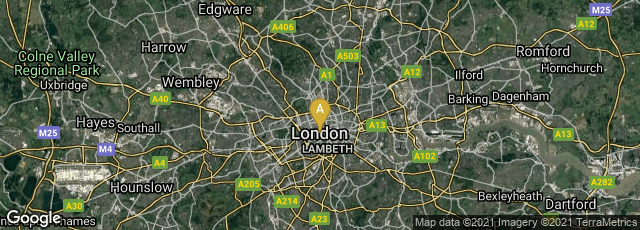

A: London, England, United Kingdom
Between April 1836 and November 1837 English writer and social critic Charles Dickens published The Posthumous Papers of the Pickwick Club, Containing a Faithful Record of the Perambulations, Perils, Travels, Adventures and Sporting Transactions of the Corresponding Members. The work was printed by London printers Bradbury and Evans for the London publishers Chapman and Hall in separate parts or fascicules sold for one shilling apiece. Written for publication as a serial, Dickens' novel, a series of loosely related adventures, is widely considered to have established the viability and appeal of the serialized format for literature. Serialization in parts enabled a wider range of customers to purchase the novel by spreading the cost over the various individual parts. Serialization also allowed the publishers to charge extra for placing advertisements inside each part. After serialization was complete the publishers Chapman and Hall issued the novel in book form.
The first printing of 1000 copies of the first part of Pickwick was difficult to sell, so the print run of the second part was reduced to 500 copies, making the first printing of the second part by far the hardest to collect today. By the third part the print run was restored to 1000 copies, after which sales of each succeeding part increased, and by the final part of Pickwick issued in November 1837 sales reached 40,000 copies. As sales of the later parts increased Dickens' publishers, Chapman and Hall, had to reprint the earlier parts twenty times.
"Thus accidentally in Pickwick Dickens and Chapman and Hall hit upon an arrangement for issuing original works of fiction in serial parts that revolutionized nineteenth-century publishing, distribution, bookselling, author-publisher relations, copyright provisions, and of course fiction itself. There are many instances of other authors such as Lever, Surtees, and Thackeray specifying a contract similar to Pickwick's, or being told that they could earn much more money if they issue their next book in serial installments like those of Dickens. The thirty-two page, two-illustration part became a standard to which the public rapidly became accustomed...." (Patten, Charles Dickens and his Publishers, 2nd ed., 2017, Chapter 3: "Pickwick Papers and the Development of Serial Fiction" p. 56).
The most details concerning the actual production of Dickens's works that I have seen is on Jane E. Chadwick's website, aninkytale.co.uk. From that I have taken the liberty of reproducing an extensive quotation:
"In order to produce this huge volume of work, Bradbury and Evans had to make full use of their stereotype foundry. This use of stereotype plates enabled them to rapidly reproduce pages of type and was a technique that Bradbury and Evans fully embraced; in May 1858 they had just over 233,400 stereotype plates in stock. [13] In order to manufacture the plates workers would need to make a mould from each page of movable type by covering the surface, held fast in a frame, with plaster of Paris. Once the plaster had dried, it was carefully removed from the frame and the type face, trimmed and neatened and then baked in an oven until all moisture was removed, a process which would take about two hours. The heat of the oven would cause a contraction of the plaster with the result that a page printed from a stereotype plate would be a few millimetres smaller than a page printed from movable type. Next the hardened mould would be placed face down on a movable cast iron plate inside a box known as a casting box, and then the box cover, which had holes at each of its corners, was held in place with a screw thus holding the mould secure. The casting box was plunged into molten metal for several minutes whilst the metal ran into the mould through the holes in the box. Then, following total immersion and cooling in water, the contents of the casting box were removed. The plaster of Paris mould would be destroyed leaving behind a newly formed metal plate. The plate would then be thoroughly checked, removing any surplus lumps of metal if found from the inside of letters, and the back of the plates would be made uniform and even before the plates were mounted ready for use.
"The process of turning Dickens' hand written manuscript into the printed word would have involved multiple skilled workers at Bradbury and Evans. The business occupied numbers 1-6 Lombard Street, giving them a vast space to work from. Compositors and Readers occupied the first floor, with presses and machinery on the ground floor, in 1842 there were six presses in total, with each machine requiring one man and two boys to work it, growing to twenty presses at the height of their success. [14] The usual working hours at the firm were 8.00am until 8.00pm, Monday to Saturday, although frequently employees were at work until 10.00pm, with all-night working not uncommon. Workers were allowed to take fifteen minutes for their lunch, an hour for dinner, and thirty minutes for tea. Deducting hours for meal times this would still mean that employees would be working in excess of sixty hours per week. Some of these workers were children; out of a staff of between three-hundred and four-hundred people in the 1850s there were fifty boys employed in the machine department alone and approximately one-hundred and fifty in the whole establishment, a figure which halved in the 1860s to a total of seven boys under the age of thirteen, and ninety-three between the ages of thirteen and eighteen. In the 1860s no women were employed under the age of eighteen. [15]
"The manuscript would most probably have been divided out among several different Compositors in the Composing Room for typesetting. In sharp contrast to the cacophonous Machine Rooms, the Composing Room would be a quiet, orderly area with each Compositor concentrating intently on the work at hand. Standing for hour after hour each day Compositors were particularly liable to suffer from varicose veins and leg ulcers, and also to eye problems such as short sightedness from concentrating and focusing on small type for prolonged periods of time. One former Compositor who worked at Bradbury and Evans for over fifty years, Charles Cawte (1832-1907), reminisced about working from Dickens' copy: "Well I remember the thick, spluttering, blue ink, quill-penned manuscript. After getting over the first few lines the copy would not have been called 'bad'- that is, from a compositor's point of view." Often working from ink splattered pages these Compositors, who needed excellent manual dexterity skills, would pick up each individual metal letter from one of two cases, designated upper and lower, which rested on a sloping frame for ease of use. Capital letters and numbers were stored in the upper case which had ninety-eight boxes, small letters and spaces in the lower case which had between fifty-three and fifty-six boxes. The Compositors would have a frame to themselves and these frames would tend to be placed with one side against a window so that during the day the Compositors were able to take advantage of the natural light. They would then place the type upside down, working from left to right, into a composing stick. Reading from the section of the manuscript that they were responsible for, they would memorise several words at a time, spelling each one out in their heads as they went along, letter by letter. An experienced Compositor would be able to set up about two-thousand letters each hour. Lines of typeface would need to be spaced and justified into an attractive layout using blank spacing bars, and spelling and punctuation skills were essential as each Compositor had to pay for any mistakes made.
"If time allowed, a galley proof would be run off on a cheaper paper and checked for mistakes in the Reading Room by Readers or 'Correctors of the Press' as they were sometimes known. Readers at Bradbury and Evans, such as Henry Vernon (b.a. 1814), were allowed to take an extra thirty minutes for their dinner if they so desired. The Readers would usually read the proof, looking for errors in the type, whilst a young boy would read aloud to them from the original copy. The galley proof was named after the tray, or galley, in which the type was placed; the proof would be on a long strip of paper with wide margins. Dickens would see, correct and revise the proofs also, he liaised frequently with Charles Hicks, the Foreman/Superintendent over these, requesting Hicks to send a boy to collect a proof from him, for instance, and speaking about receiving another proof from Hicks the following morning. These young Warehouse Boys would be used for all manner of menial jobs such as sweeping up, making up the fires, taking and receiving messages and running errands. Once the Readers and author were satisfied with the revisions and corrections to the galley proofs, these would be taken back to the Compositors who would make the necessary alterations, before making the type up into pages. The type would be carefully slid from the galley on to a large flat stone surface before a chase, or frame, was placed around it. The type was then locked into position using blocks known as quoins. Page proofs would then be printed off and a final proof would be read by the Readers and the author.
"The next stage was the final print. In addition to their much smaller presses, Bradbury and Evans had erected a printing machine based on a design by Augustus Applegath assisted by Thomas Middleton, an engineer from Southwark. This enormous, noisy, steam driven machine, stood approximately thirteen feet high and fourteen feet in length, and was capable of producing four-thousand two-hundred impressions an hour. This single machine had the capacity of four presses, with four places in which the Pressmen would insert paper, four cylinders to carry out the printing, and four points at which the printed sheets were delivered to the waiting men. The Superintendent in the Machine Room in the 1840s was George Gifford Beard, who interestingly was also the Landlord of the White Swan public house on Fetter Lane, London, a public house which was much frequented by printers. He was kept so busy with his work at Bradbury and Evans that his wife Mary was left to manage the pub for him! Once printed the damp sheets would be carried through to the Warehouse for processing. Warehousemen and Under Warehousemen such as Michael Fitzhenry and Robert Rowen would take the wet papers through to the heated Drying Room, and arrange the papers to dry over lines arranged around the room. Pipes in the room would be heated by steam and the pages left to dry for around twelve hours in this well-ventilated but warm environment. Once dry the work would be pressed by placing each individual sheet between glazeboards and inserting in a hydraulic press. After 'booking' or collation, done by gathering up from a table the separate pages of the work, starting with the last page and working towards the first, the work would be passed on to Book Binders, where it would be stitched and bound into the finished work...."